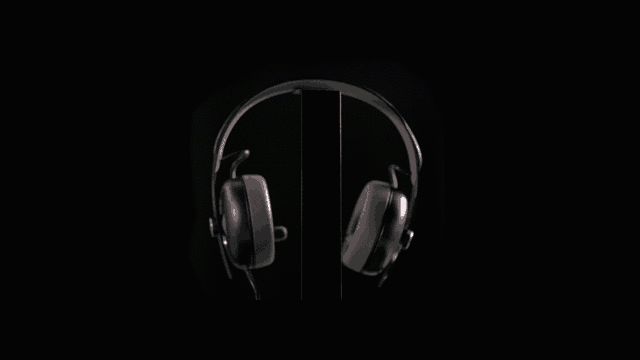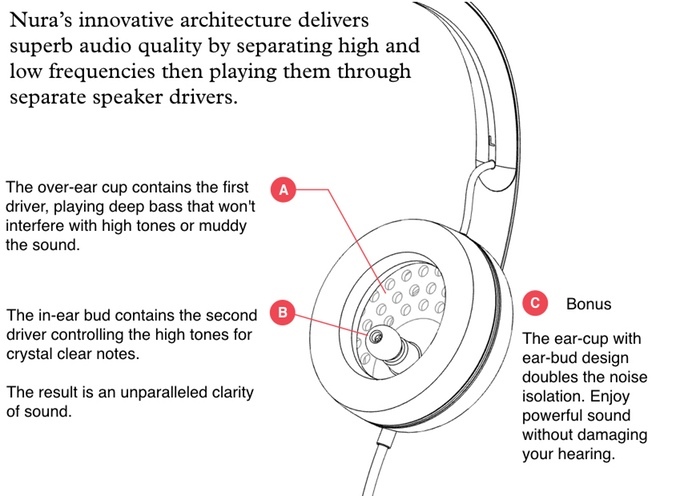From physiology to the gadget: headphones that adapt sound to the ears - ambitious startup Nura
Many are waiting for the moment when audio gadgets can take into account their personal preferences in the features of music playback, independently adjusting to the features of hearing. In the past year 2016, the creator of Nura, Kyle Slater, said that he and his project team managed to develop a design that makes such dreams come true.

Kyle Slater
')
Many have already believed in the big words of the developers: the project received tangible support on the Kickstarter Kraut-funding platform. The promises of the creators of the new audio equipment still have to pass the test of time, but the principles of operation embodied in the device, in our opinion, deserve attention and lively discussion.

Some GT users, in the comments to our posts, noted that the subjective assessment of acoustic characteristics should take into account the anatomical and physiological characteristics of a particular ear, and the selection of headphones is strictly individual. Psychoacoustic studies (and independently of them as a video blogger Stalker) proved that we all hear differently. This applies to both the frequency response and tonal characteristics, not to mention the perception of loudness. It is from the above-described properties of human hearing that developers repelled when creating new headphones. To implement their ideas, the authors of a technical startup used several original design features and special software.

a graph showing the differences between the perception of the frequencies of different listeners
The main feature underlying this product was the concept, according to which we all hear in different ways. Therefore, to achieve the most comfortable sound, we need a certain universal principle of adjustment (adaptation) of the device under the listener's ears.

The source of information for tuning Nura has become otoacoustic emission. This phenomenon is the generation of sound by the hair cells of the cochlea. In other words, our hearing aid itself is a source of sound waves that travel from the inner ear to the outer ear canal. The phenomenon itself was experimentally proved by David Kemp back in 1978. During the development of Nura, Slater’s team revealed a relationship between the individual acoustic characteristics of our ears, differences in perception of frequencies, and the characteristics of the waves of otoacoustic emission.
Sensitive microphones, located in a full-size headphone unit, pick up the sound of our ears and send a signal to a digital module that analyzes the received data and sets the appropriate sound processing characteristics.
The details of the algorithm that analyzes and adjusts are still a mystery. It is known that headphones create a unique profile for each user, which stores data on the frequency response and other characteristics of its auditory tract. According to manufacturers, the headphones can even identify (recognize) a particular user when he puts them on.

In this case, the developers do not disclose information about which processing the signal arriving at the device is subjected to, or what characteristics the software module is capable of analyzing. In this case, the system collects and analyzes information in 30 seconds. During this time, the headphones send a series of signals and take back the waves of otoacoustic emission. According to the manufacturer, the Nura system analyzes how well the signals of a particular frequency reach the brain.
To obtain the desired result, Nura applied the original design solution - they combined the bill of lading and the in-channel type of headphones in one device. According to the Nura engineers, the mid-high-frequency radiator is located in the intra-channel blocks of the device, and the overhead part where the subwoofer is located is a peculiar subwoofer.

According to the creators of the gadget, the principles of the location of the emitters allow you to achieve an accented sound in the entire frequency range without prejudice to the formation of realistic surround stereo. The assertion about the quality scene raises the most significant doubts. Often, crossovers of multiband speakers, including headphones, are a source of phase distortion, which can negatively affect the scene. At the same time in the promotional materials of the developers a special emphasis is placed on the formation of surround sound.

Another feature of the design of new headphones will be increased sound insulation, which was achieved by combining the intra-channel module and the full-sized bowl. Obviously, this design ensures the intimacy of listening, while there may be difficulties when using on the street. It is known that "silencing" headphones sometimes become an indirect cause of accidents involving pedestrians. At the same time, the isolation of the headphones has soy advantages. In situations where the device is used in the metro or in noisy places, there is no need to apply volume levels that are dangerous for the sensory system of the inner ear.
In March of this year, the start of small-scale production of Nura is planned, and in May - the start of mass production. By now, it remains a question whether the Nura team will be able to find a “small audiophile”, tired of searching for “its own” sound, in the mass consumer’s mind. I personally really want to believe the manufacturer, since the concept of combining headphones, a measuring device and a correction module in one device is a bold and fundamentally new solution. Unfortunately, I have not had a chance to personally evaluate the device, but the feedback on prototypes from exhibitions is very promising.

It is impossible to exclude the possibility of so-called. marketing "innovation", but, I repeat, I really want to believe in the honesty and ideology of the developers. Show, as you know, an autopsy, maybe I will get the product from the first production batch, in this case I will entrust the product evaluation to the Pult technical specialists and will necessarily publish their findings on the product.
The important point is that we do not sell these headphones and do not advertise them, we just find the topic rather relevant. At the same time, if the promises of manufacturers are a reality, and the principles described really work, then we do not exclude the appearance of this device in our store. We sincerely hope for a lively discussion about this product and the principles laid down in the idea of its creation.

“Being a music lover throughout life, as well as an engineer, I began to systematically search for the perfect pair of headphones and found that headphones, like shoes, the ideal depends on who wears them. This led to the realization that the headphones must understand the particular hearing of a particular person and be able to adapt to the listener. ”
Kyle Slater
')
Many have already believed in the big words of the developers: the project received tangible support on the Kickstarter Kraut-funding platform. The promises of the creators of the new audio equipment still have to pass the test of time, but the principles of operation embodied in the device, in our opinion, deserve attention and lively discussion.

Some GT users, in the comments to our posts, noted that the subjective assessment of acoustic characteristics should take into account the anatomical and physiological characteristics of a particular ear, and the selection of headphones is strictly individual. Psychoacoustic studies (and independently of them as a video blogger Stalker) proved that we all hear differently. This applies to both the frequency response and tonal characteristics, not to mention the perception of loudness. It is from the above-described properties of human hearing that developers repelled when creating new headphones. To implement their ideas, the authors of a technical startup used several original design features and special software.

a graph showing the differences between the perception of the frequencies of different listeners
Ear Examining Headphones
The main feature underlying this product was the concept, according to which we all hear in different ways. Therefore, to achieve the most comfortable sound, we need a certain universal principle of adjustment (adaptation) of the device under the listener's ears.

The source of information for tuning Nura has become otoacoustic emission. This phenomenon is the generation of sound by the hair cells of the cochlea. In other words, our hearing aid itself is a source of sound waves that travel from the inner ear to the outer ear canal. The phenomenon itself was experimentally proved by David Kemp back in 1978. During the development of Nura, Slater’s team revealed a relationship between the individual acoustic characteristics of our ears, differences in perception of frequencies, and the characteristics of the waves of otoacoustic emission.
Sensitive microphones, located in a full-size headphone unit, pick up the sound of our ears and send a signal to a digital module that analyzes the received data and sets the appropriate sound processing characteristics.
The details of the algorithm that analyzes and adjusts are still a mystery. It is known that headphones create a unique profile for each user, which stores data on the frequency response and other characteristics of its auditory tract. According to manufacturers, the headphones can even identify (recognize) a particular user when he puts them on.

In this case, the developers do not disclose information about which processing the signal arriving at the device is subjected to, or what characteristics the software module is capable of analyzing. In this case, the system collects and analyzes information in 30 seconds. During this time, the headphones send a series of signals and take back the waves of otoacoustic emission. According to the manufacturer, the Nura system analyzes how well the signals of a particular frequency reach the brain.
New class - full-size-channel
To obtain the desired result, Nura applied the original design solution - they combined the bill of lading and the in-channel type of headphones in one device. According to the Nura engineers, the mid-high-frequency radiator is located in the intra-channel blocks of the device, and the overhead part where the subwoofer is located is a peculiar subwoofer.

According to the creators of the gadget, the principles of the location of the emitters allow you to achieve an accented sound in the entire frequency range without prejudice to the formation of realistic surround stereo. The assertion about the quality scene raises the most significant doubts. Often, crossovers of multiband speakers, including headphones, are a source of phase distortion, which can negatively affect the scene. At the same time in the promotional materials of the developers a special emphasis is placed on the formation of surround sound.

Another feature of the design of new headphones will be increased sound insulation, which was achieved by combining the intra-channel module and the full-sized bowl. Obviously, this design ensures the intimacy of listening, while there may be difficulties when using on the street. It is known that "silencing" headphones sometimes become an indirect cause of accidents involving pedestrians. At the same time, the isolation of the headphones has soy advantages. In situations where the device is used in the metro or in noisy places, there is no need to apply volume levels that are dangerous for the sensory system of the inner ear.
The result - an autopsy will show
In March of this year, the start of small-scale production of Nura is planned, and in May - the start of mass production. By now, it remains a question whether the Nura team will be able to find a “small audiophile”, tired of searching for “its own” sound, in the mass consumer’s mind. I personally really want to believe the manufacturer, since the concept of combining headphones, a measuring device and a correction module in one device is a bold and fundamentally new solution. Unfortunately, I have not had a chance to personally evaluate the device, but the feedback on prototypes from exhibitions is very promising.

It is impossible to exclude the possibility of so-called. marketing "innovation", but, I repeat, I really want to believe in the honesty and ideology of the developers. Show, as you know, an autopsy, maybe I will get the product from the first production batch, in this case I will entrust the product evaluation to the Pult technical specialists and will necessarily publish their findings on the product.
The important point is that we do not sell these headphones and do not advertise them, we just find the topic rather relevant. At the same time, if the promises of manufacturers are a reality, and the principles described really work, then we do not exclude the appearance of this device in our store. We sincerely hope for a lively discussion about this product and the principles laid down in the idea of its creation.
Source: https://habr.com/ru/post/400687/
All Articles